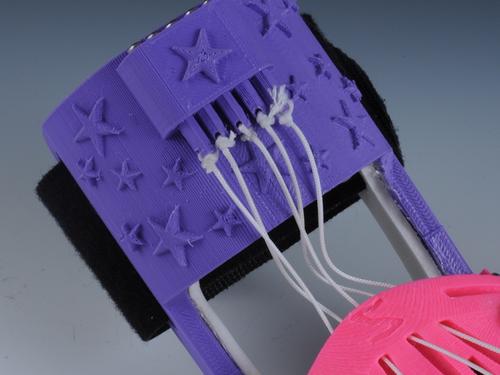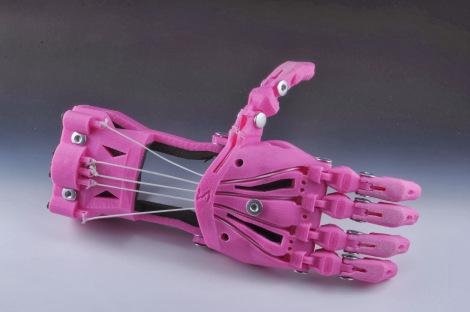3D-Printed Limbs Turn Kids into Superheroes
September 30, 2014

Enabling the Future is designing prosthetic appendages modeled more like superhero arms and hands than your average static artificial limbs. And they're doing it through a website and grassroots movement inspired by two men's design and creation in 2012 of a metal prosthetic for a child in South Africa.
Back then, American prop maker Ivan Owen and South African carpenter Richard Van As designed and printed a mechanical hand for a boy named Liam, Jen Owen, Ivan's wife and communications director for the Enabling the Future, told Design News.
In January 2013, Makerbot heard of their design and donated two 3D printers to the pair. By the end of the month, they released the files for the device as open source so anyone who needed it could use it.
Click on the image below to see some of these "superhero" prosthetics.

Though the two men have parted ways professionally, that one act helped establish Enabling the Future, which has grown to more than 1,500 members who are creating and designing 3D-printed prosthetic e-NABLE devices for kids in need around the world, Jen Owen said.
The group formed in 2013 when Jon Schull, a professor at RIT, saw a YouTube video of Owen and Van As' work and noticed that people commenting on the video offered the use of their own 3D printers to develop more hands for kids. "Jon realized that there was huge potential in this and created an online map and suggested that anyone interested in making hands, too, should put their names on the map so that people who needed a 3D-printed hand could find them and get parts made," Jen Owen told us.
That group now maintains a website, social-media pages, and an interactive map that pairs children that needs hands with Enabling the Future partners. "Originally, the map was about getting people with 3D printers to create the original design, but it quickly turned into research and development teams who took the original that Ivan and Richard had created and shared and turned it into about 10 new designs so far," Jen Owen explained to Design News. "Every day we find someone that has changed and modified the design a little further or done something completely new."
She said it's been "amazing" to watch how one idea for one person has gone viral across the world through the use of the Internet and other media. "At first it was about 70 or so people who listed themselves on the map who were willing to print that original hand design," she told us. "A year and a half later we have a Google+ group with over 1,800 people -- which is growing by about 50 too 100 or more a day lately -- who have volunteered their time and talents to helping make free 3D-printed hands for children and adults in need."
To date, there are about 10 different versions and designs of prosthetic hands. The hand designs are more playful than usual, well suited for children who need prosthetics but may not be able to afford them. "Until now there really wasn't much available for children because they grow too fast and commercial prosthetic devices are in the thousands of dollars," Jen Owen told us. "So when your child is outgrowing a device two to three times a year, you can imagine the impossible cost for a majority of parents and families."
3D printing allows the group to create devices that cost about $50 in materials for kids and when they outgrow them, the file size can be increased and printed again.
To be fitted with a prosthetic, parents can contact the group via an intake form on which they provide measurements and photographs that can be sent to the volunteer that's offered to print the parts or create the device, Jen Owen said. "Every hand has to be custom made and sized appropriately but that is easily done with 3D printing, as you simply type in the percentage of size needed and the machine prints it out," she told us. "Some children are in need of more customization to accommodate for different hand shapes or for those that have functional thumbs."
The group is currently working on body-powered designs for kids who don't have a functional wrist required to power the hand designs that are currently available. "We have some prototypes and we are very close to releasing a completed arm design," Jen Owen said.
Related posts:
About the Author(s)
You May Also Like
.jpg?width=300&auto=webp&quality=80&disable=upscale)


